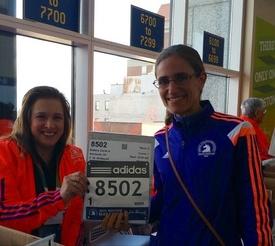Running Form, Injury, and Orthotics

badgeratheart
Posts: 91 Member
Within the past 8 months, I have received a lot of conflicting advice from medical professionals about a bulging disc injury I suffered in August, 2014 and how to return to running. I'm trying to make sense of it all and am wondering if any of you can direct me to reliable, unbiased information as I make decisions about how to proceed. Please weigh in with your opinions and experiences, as relevant. I know to trust medical professionals rather than that of strangers on the internet, but their opinions conflict, so I'm interested in gathering any information I can.
A bit of information about me. I am a 41 yo woman. I have been running off and on, but mostly on, since I was 9 yo. I have had 3 ACL reconstructions from basketball (+ meniscus cartilage tear), skiing, and kickboxing injuries. Despite having been a competitive runner in my teens and a recreational runner (a couple of 5K's and 10K's each year) in my twenties and thirties, I NEVER experienced a running related injury until I was 40. I had a bulging disc (L5, S1) in my low back, but there was no trauma (accident, fall, lift, etc.) that set it off. The only potential cause was an increase in mileage over what I had been running.
Here's the timeline of events related to my injury and recovery:
[*] September, 2014--Completed the course of Prednisone which had little to no impact and MRI confirmed L5, S1 disc bulge. GP referred me to a neurosurgeon. While waiting to get into the neurosurgeon on September 29, the symptoms slowly subsided and were virtually gone, except for the loss of strength. Neurosurgeon orders 8 weeks (16 sessions) of physical therapy and directs met to avoid all weight bearing activity for the purpose of exercise until our follow up appointment. Allowed swimming, stationary recumbent bike, yoga (but no "crazy" poses), and seated weight lifting during this time.
[*] October through November, 2014--follow neurosurgeon and physical therapist protocol exactly as prescribed. There was not a single time that broke the "rules" because the last thing I wanted to do was risk re-injury. Sign up for a gait analysis running clinic through the PT office for December. November 25 was cleared by the neurosurgeon to return to regular activities, including running, though he lectured me about how horrible running is for low back and explained that he advises all of his patients to avoid running for exercise.
[*] December, 2014--begin reintroducing running through run/walk intervals on the indoor track per plan advised by my PT. 4th time out, symptoms return. Numbness, tingling and loss of strength were all present. Postpone gait analysis to the April, 2015 running clinic date. Cease running and revert to pool, yoga, bike and weights, while I wait for January and our PPO (had been HMO) to arrive.
[*] January, 2015--Not going to return to anti-running neurosurgeon and instead consult with sports med focused chiropractor. He is not big on adjustments and promotes paying attention to the whole kinetic chain. I detail activities I had been doing at PT and provide him with a list she gave me. He makes the comment, "Sounds like they threw everything including the kitchen sink at your core during PT and you wound up back where you started." I think, "Yes! That's exactly how I feel!" Assesses that my core and back strength were good, as a result of PT, flexibility is good (thank you, yoga!) and theorizes that my gait--specifically pronation--was the trigger of kinetic chain issues that resulted in the bulging disc injury.
[*] February, 2015--Chiropractor measures and casts me for orthotics in his office. He took video of my walking gait, but never watched me run. Prescribes a series of exercises to activate glutes, keep knees aligned, and prevent pronation. I work this program as faithfully as I had at PT. Left leg illiotibial band starts giving me problems. Chiropractor uses massage, stretching, foam rolling, Graston technique, and kinesio tape to address it.
[*] March, 2015--Orthotics arrive! I break them in as prescribed, slowly working up from 3 hours per day until I can tolerate them well and actually prefer the way it feels to wear them rather than not wear them. I use them in my stability running shoes (Brooks Adrenaline series) that I had been wearing pre-injury, but a brand new pair of the same shoe. After 2 weeks, I begin run/walk intervals. IT band is still pretty cranky.
[*] April, 2015--Begin outdoor running. 3 miles/3X per week at first and have worked up to a total of 13 miles per week maximum. BOTH IT bands are cranky and require a lot of attention with stretching, icing, foam rolling, etc., but I'll take it because there are no disc problems and I'm running! Still frustrating because I've never had IT issues before.
[*] April 25, attend gait analysis running clinic. It was a pretty comprehensive experience including assessments of my injury history, training plan, flexibility, strength and functional tests, foot biomechanics, and video tape of me running from the front and side for the gait analysis. Per their assessment, I have relatively high arches, do not pronate and that if the bulging disc was caused by running, it is not from a foot, ankle, or knee issue. One PT said, "You don't have a neutral foot, but it's pretty darn close!" Perhaps something higher up the chain, maybe hips, is the culprit, so 5 (!) different PT's watch me run on the treadmill. They note that I have a slight over rotation of my trunk, the I lean forward a bit which pushes the bottom out and causes hip flexor issues, I heel strike, my right hip drops some as I stride on the left, my steps cross the midline of my body, and my cadence (164) is a bit slow. They video me again running at a 180 cadence which corrects the lean, promotes a mid-foot strike and some of the hip drop is corrected. They advise that the orthotics, coupled with a stability shoe, are way too much for me and likely the reason my IT Bands are so irritated. Suggest I ditch the orthotics and stay in a stability shoe or keep the orthotics but use in a neutral shoe. They also assess glute medius and hip flexor weakness, prescribing exercises to address those deficits as well as some core strengtheners to address the trunk rotation.
[/list]
So, given that comprehensive history, with the advice of a lot of different medical professionals leaves me thoroughly confused. I just want to be able to run again!!! Where do I go from here?
I appreciate your thoughts, references, and sharing of experience.
A bit of information about me. I am a 41 yo woman. I have been running off and on, but mostly on, since I was 9 yo. I have had 3 ACL reconstructions from basketball (+ meniscus cartilage tear), skiing, and kickboxing injuries. Despite having been a competitive runner in my teens and a recreational runner (a couple of 5K's and 10K's each year) in my twenties and thirties, I NEVER experienced a running related injury until I was 40. I had a bulging disc (L5, S1) in my low back, but there was no trauma (accident, fall, lift, etc.) that set it off. The only potential cause was an increase in mileage over what I had been running.
Here's the timeline of events related to my injury and recovery:
[*] September, 2014--Completed the course of Prednisone which had little to no impact and MRI confirmed L5, S1 disc bulge. GP referred me to a neurosurgeon. While waiting to get into the neurosurgeon on September 29, the symptoms slowly subsided and were virtually gone, except for the loss of strength. Neurosurgeon orders 8 weeks (16 sessions) of physical therapy and directs met to avoid all weight bearing activity for the purpose of exercise until our follow up appointment. Allowed swimming, stationary recumbent bike, yoga (but no "crazy" poses), and seated weight lifting during this time.
[*] October through November, 2014--follow neurosurgeon and physical therapist protocol exactly as prescribed. There was not a single time that broke the "rules" because the last thing I wanted to do was risk re-injury. Sign up for a gait analysis running clinic through the PT office for December. November 25 was cleared by the neurosurgeon to return to regular activities, including running, though he lectured me about how horrible running is for low back and explained that he advises all of his patients to avoid running for exercise.
[*] December, 2014--begin reintroducing running through run/walk intervals on the indoor track per plan advised by my PT. 4th time out, symptoms return. Numbness, tingling and loss of strength were all present. Postpone gait analysis to the April, 2015 running clinic date. Cease running and revert to pool, yoga, bike and weights, while I wait for January and our PPO (had been HMO) to arrive.
[*] January, 2015--Not going to return to anti-running neurosurgeon and instead consult with sports med focused chiropractor. He is not big on adjustments and promotes paying attention to the whole kinetic chain. I detail activities I had been doing at PT and provide him with a list she gave me. He makes the comment, "Sounds like they threw everything including the kitchen sink at your core during PT and you wound up back where you started." I think, "Yes! That's exactly how I feel!" Assesses that my core and back strength were good, as a result of PT, flexibility is good (thank you, yoga!) and theorizes that my gait--specifically pronation--was the trigger of kinetic chain issues that resulted in the bulging disc injury.
[*] February, 2015--Chiropractor measures and casts me for orthotics in his office. He took video of my walking gait, but never watched me run. Prescribes a series of exercises to activate glutes, keep knees aligned, and prevent pronation. I work this program as faithfully as I had at PT. Left leg illiotibial band starts giving me problems. Chiropractor uses massage, stretching, foam rolling, Graston technique, and kinesio tape to address it.
[*] March, 2015--Orthotics arrive! I break them in as prescribed, slowly working up from 3 hours per day until I can tolerate them well and actually prefer the way it feels to wear them rather than not wear them. I use them in my stability running shoes (Brooks Adrenaline series) that I had been wearing pre-injury, but a brand new pair of the same shoe. After 2 weeks, I begin run/walk intervals. IT band is still pretty cranky.
[*] April, 2015--Begin outdoor running. 3 miles/3X per week at first and have worked up to a total of 13 miles per week maximum. BOTH IT bands are cranky and require a lot of attention with stretching, icing, foam rolling, etc., but I'll take it because there are no disc problems and I'm running! Still frustrating because I've never had IT issues before.
[*] April 25, attend gait analysis running clinic. It was a pretty comprehensive experience including assessments of my injury history, training plan, flexibility, strength and functional tests, foot biomechanics, and video tape of me running from the front and side for the gait analysis. Per their assessment, I have relatively high arches, do not pronate and that if the bulging disc was caused by running, it is not from a foot, ankle, or knee issue. One PT said, "You don't have a neutral foot, but it's pretty darn close!" Perhaps something higher up the chain, maybe hips, is the culprit, so 5 (!) different PT's watch me run on the treadmill. They note that I have a slight over rotation of my trunk, the I lean forward a bit which pushes the bottom out and causes hip flexor issues, I heel strike, my right hip drops some as I stride on the left, my steps cross the midline of my body, and my cadence (164) is a bit slow. They video me again running at a 180 cadence which corrects the lean, promotes a mid-foot strike and some of the hip drop is corrected. They advise that the orthotics, coupled with a stability shoe, are way too much for me and likely the reason my IT Bands are so irritated. Suggest I ditch the orthotics and stay in a stability shoe or keep the orthotics but use in a neutral shoe. They also assess glute medius and hip flexor weakness, prescribing exercises to address those deficits as well as some core strengtheners to address the trunk rotation.
[/list]
So, given that comprehensive history, with the advice of a lot of different medical professionals leaves me thoroughly confused. I just want to be able to run again!!! Where do I go from here?
I appreciate your thoughts, references, and sharing of experience.
0
Replies
-
Wow. That is a lot that you have been through. I hope you find the right solution.
I think if it were me I would go with the latest round of advice. It seems your orthotics and stability shoes helped you and allowed you to run again, but not ideally due to the ITband issues. Since the latest advice has a little of that, but seems to address what they feel stressed your IT band, I'm not sure what they are suggesting really conflicts, but enhances and builds upon the prior work.
Then again, I only know from what I read above, I am very distant from this. And...not qualified to help. I just mentioned what I would probably do in your position is all.0 -
The last part of your story sounds alot like mine, except no bulging disc. It sounds like the 5 PTs who watched you run on a treadmill agreed with what they saw, so that says something right there. How many of them have a specialty in running or are runners themselves? I have ITBS and the same hip drop (Trendenlenburg Gait) that points to hip flexor and glute weakness. Keep doing the glute/hip exercises, to strengthen those areas, it does help. I've been doing those exercises for almost a year now and am just starting to feel normal and that I may finally be able to shoot for a half marathon this year

I see what you mean about somewhat conflicting guidance. Just out of curiosity, do you have a desk job? My PT's said that sitting on your butt all day doesn't help hip flexibility. Since you're feeling a little better I think sticking w/ the Sports Med doc is a good plan. If he doesn't do a gait analysis while you're running, I would ask for one. Going to a neutral shoe might not be a bad idea either, because it will have less impact on your gait. Run it by the Sports Med doc, though just to be sure. When I had a gait analysis done, mine was actually done while running barefoot.
I'm no expert, but this is based on what I learned from suffering through similar symptoms. I had the numbness and tingling, but I never lost any strength.
0 -
Laura732--Thanks for sharing your experience. Yes, I do have a desk job and know that it's not kind to my hips...or really anything else. Good point about 5 PT's drawing the same conclusion at the same time as well. I appreciate your advice.
JarethG--I'm sure runners do make a lot of money for PT's. And, while I've been to more than my share of physical therapy throughout the years, it's all been related to knee injuries suffered in lateral motion sports and once from pregnancy complications. In 30+ years of running, this is the first time I've ever been to PT for a running related injury. That just adds to the frustration.0 -
I have not had a functional movement assessment done. Can you tell me more about it?0
-
badgeratheart wrote: »Where do I go from here?
It's hard to give advice without seeing you run, but why not try the advice you got on April 25 and see what happens. The forward lean, over-rotation, and bulging disk makes sense given your desk job.
By the way, i'd transition* to lower-heeled footwear, and eventually to thinner soles, like minimalist shoes. That will encourage a softer and more natural landing than the raised heel of the Brooks.
* the transition shoe would have about 3 mm less of a heel drop, and every few months, use a shoe with 3 mm less of a drop.
0 -
"Ready to Run: Unlocking Your Potential to Run Naturally" Dr. Kelly Starrett...after years of ankle, foot, and shin splint problems, I read this book and started doing the practices in it. Slowly back up to 1/2 mile at a time so far with no shin splint issues and no ankle pain. Quitting running was not an option for me (Air Force makes it mandatory).0
-
Cherimoose--thanks for the time on the minimalist running shoes. I've been interested, but always feel like everything I read about them seems pretty one-sided and biased. I'll keep looking.
HereWeGo--great tip on the book. I will certainly be checking it out!0 -
badgeratheart wrote: »Cherimoose--thanks for the time on the minimalist running shoes. I've been interested, but always feel like everything I read about them seems pretty one-sided and biased.
IMO all running books are biased. some of the minimalist books read (almost) like esoterics....
still, i've read a few...
a more scientific based one is "Natural Running" by Danny Abshire - if i remember correctly, he tries to sell you on a training program/system/app, but if you ignore that it's an interesting read on the biomechanics of running and shoes....
Another one for injury prevention is "running on air" by Budd Coates. A bit long-winded (pardon the pun), for something that could be explained in an article, rather than a book, but he makes sense (to me anyways). In a nutshell, it is about how an even-count breathing pattern puts more stress on one side of your body, and how to breathe so this doesn't happen....0 -
badgeratheart wrote: »Cherimoose--thanks for the time on the minimalist running shoes. I've been interested, but always feel like everything I read about them seems pretty one-sided and biased. I'll keep looking.
HereWeGo--great tip on the book. I will certainly be checking it out!
@badgeratheart , she did not suggest minimalist shoes.
She suggested a lower drop shoe.
Which does not translate to a minimal shoe.
This is a zero drop shoe:
With a maximal stack height.
The Newton Aha has a 6mm drop but a low stack height.
She was suggesting changing the heel-toe drop, mentioned nothing about stack height.0 -
badgeratheart wrote: »I have not had a functional movement assessment done. Can you tell me more about it?
Here is info on the FMS:
http://www.functionalmovement.com/fms
I would assume one of the PTs the did the gait analysis would be trained to do it.
Sort of funny, I sucked at the FMS (upper body issue), but the same PT doing the gait analysis told me that if all the runners he worked with had my form he'd be out of business.
You mentioned disc herniation. I was told by a neurosurgeon that a high % of the population will show disc herniation on an MRI. I crawling on the floor for 4 days back pain. When I was examined I was told I had inflammation in my SI joint and possibly irritation of the psoas. Issues with these body parts results in pain similar to disc issues. You might want to look up some info on these.
0 -
I am not a professional, but I do gait analysis and sell shoes as a job, and the big thing that jumped out at me is that you are wearing an arch in an arch support shoe. thats a lot of arch. When people come to me with an orthotic, we seek a neutral shoe to put that arch into, we don't lay it on top of a stability shoe sole. The issue with doing that is that then you create a tendency to roll to the outside, which is often felt in the IT band.
Did they look at your gait in a neutral shoe? In the gait analysis where you were "almost neutral", were you wearing a neutral shoe?0 -
also, I do this routine twice a week. I started with the numbers on the PDF and then added reps. Now I do 20 reach exercise twice through or 30 reps once through. great for the hip area:
http://www.njsportsmed.com/files/myrtl_routine.pdf0
This discussion has been closed.
Categories
- All Categories
- 1.4M Health, Wellness and Goals
- 398.2K Introduce Yourself
- 44.7K Getting Started
- 261K Health and Weight Loss
- 176.4K Food and Nutrition
- 47.7K Recipes
- 233K Fitness and Exercise
- 463 Sleep, Mindfulness and Overall Wellness
- 6.5K Goal: Maintaining Weight
- 8.7K Goal: Gaining Weight and Body Building
- 153.5K Motivation and Support
- 8.4K Challenges
- 1.4K Debate Club
- 96.5K Chit-Chat
- 2.6K Fun and Games
- 4.8K MyFitnessPal Information
- 13 News and Announcements
- 21 MyFitnessPal Academy
- 1.6K Feature Suggestions and Ideas
- 3.2K MyFitnessPal Tech Support Questions








